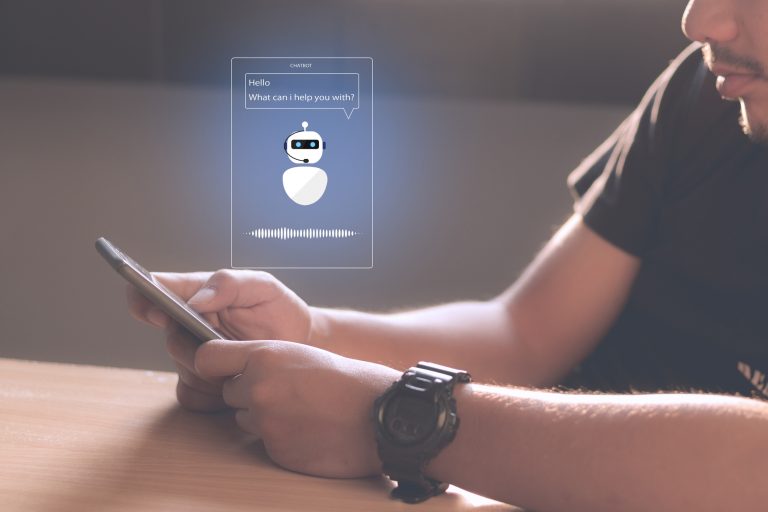Customer interaction with digital assistants also poses challenges
An increasing number of customers use digital channels to interact with their bank or to submit their requests quickly and in a targeted manner. Every successfully completed digital customer interaction saves valuable employee resources compared to an on-site advisory service. Moreover, these interactions often result in enormous opportunities, as the collected data and information can be used for the subsequent sales and consulting process.
Purely digital customer interaction with digital assistants, however, also poses challenges. From the customer’s point of view, a mediocre or even poorly functioning digital customer interface quickly leads to considerable frustration and, as a result, could even have a lasting negative impact on customer interaction in general.
Digitalization pressure at the customer interface
The pressure on banks to improve their customer interface and align it more closely with their respective expectations is constantly increasing. Customers rapidly become accustomed to the solutions that suit them best and which they already know from other business areas. They therefore feel inconvenienced when they find them missing in important parts of their everyday lives. When bank customers have a specific request, for example, they often have to navigate between online contact forms and queries via their online or mobile banking inbox, or wait on hold at the customer service center. Customers still have the choice of stopping at the branch, of course, but nowadays only a handful of customers choose this option for their service requests.
Technological progress fuels customer expectations
In 2018, Google presented its Assistant’s ability to make an appointment with a hairdresser by phone on behalf of the user. This clearly showed the potential of natural language understanding and its integration into digital assistants. More than 20% of Germany’s households[1] now have a digital voice assistant, such as Alexa or Google Home, which responds to its users’ queries and thus helps to make their day-to-day life a little easier.
When taking a look at the banking market, it is evident that banks are often still a long way from providing such solutions for their customers. However, the customer expectations that Google aims to meet, equally apply to banks:
- 24/7: the goal is to be able to transmit and resolve requests at any time and from anywhere.
- Fast: once a request is initiated, it should be resolved immediately.
- Easy and intuitive: establishing contact as well as transmitting information is completed with just a few clicks or by answering short questions and does not involve any media breaks.
- Goal-oriented: the process is designed to query only those issues that really contribute to solving the specific problem.
In the past years, banks have been working continuously to improve their customer interface by aligning it more closely with their respective needs. As part of digitalization projects, for example, they have implemented a large number of self-service applications. Today, it takes just a few clicks for customers to conveniently change their own address in the online or mobile banking application. Even bank transfers no longer have to be handed in personally at the branch, but are entered and authorized by the customers. All in all, customers can now carry out many transactions themselves, which previously required interaction with a bank employee. It is therefore important for banks to continue to focus on this development in the coming years and make the process even more intuitive and easier.
BankingHub-Newsletter
Analyses, articles and interviews about trends & innovation in banking delivered right to your inbox every 2-3 weeks
"(Required)" indicates required fields
Digital assistants as an option for future-oriented customer interaction
Chatbots can be used to further increase efficiency at the customer interface. They accept customer requests made in natural language and understand the customer’s intention from the message content. The user has two different options to interact with the bot:
- In text form via chatbot: these are embedded in the bank’s website, in the mobile app, or even connected to popular messenger services.
- Through speech via voicebot: in addition to the traditional phone call to the customer service center, it is also possible to communicate via voice messages in corresponding services.
At present, chatbots and voicebots in the banking business focus primarily on processing service requests. A large proportion of the requests made to the customer service center, for example, can be recorded and processed by using this technology. In the insurance sector, such bots can also be used to transmit damage reports and answer queries about insurance coverage.
The number of use cases for digital assistants is growing significantly
Bots can also be used for a variety of other use cases. We have already mentioned the standard bot for processing general service requests.
Additionally, it is possible to provide complete product advice and conclude contracts, especially for simpler products with little need for advice, such as foreign travel health insurance.
Customized bots for specific offers also provide helpful support. When new account models are introduced, for example, the bank can grant the customers the option to select the account model that best suits their needs and to initiate a corresponding change accordingly.
Bots are also being used more and more frequently in the area of conversational marketing to generate new leads and for activities such as scheduling a meeting with the financial advisor etc.
In theory, it would be possible to use digital assistants in almost all areas of customer interaction. The extent to which the topic becomes established and bank customers can and will use this service depends on various factors and will unfold over the next few years. In addition, various use cases are also conceivable outside the customer interface, e.g. the automation of support functions for internal HR and IT areas.
Economic added value as a trigger for use case implementation
Depending on the use case, digital assistants have various effects on banks’ profit and loss statements. In principle, they can contribute to saving costs and generating additional income. The cost savings mainly result from the reduction of personnel expenses for the activities that are taken over by the bot. Using bots for lead generation, for example, generates increased (commission) income. It is therefore important to clearly identify the use case and prepare a corresponding business case so that the bank can evaluate the investment and its returns in advance.
Benefits of modern customer interaction for banks’ business model:
Customer interaction of the future: An explorative and incremental approach makes sense
As already mentioned, an important success factor is to select a specific use case and to perform a clear requirements analysis beforehand, using various proven methods, such as the value-irritant matrix. We also recommend adopting an explorative and incremental approach for implementation.
The immediate goal of implementing a dialog-oriented bot for the customer service center is not to handle 100% of customer service requests from start to finish, but to conclude a large portion of the most frequent ones. Where functions are missing, the customer is forwarded – preferably without a media break – to an employee in the customer center, who picks up at the point where the bot can no longer help.
The bot’s functionalities are then gradually expanded and constantly improved. This is possible because in the course of every customer interaction with a bot, data is collected from which the bot can then “learn” – provided the customer agrees to this. This allows, for example, to analyze reasons for cancellations and to identify new customer requests that as yet cannot be processed from start to finish, but which are arising in ever greater numbers.
Overall, digital assistants offer a great opportunity for banks to further digitalize their customer interface and align it with their respective needs. These assistants represent an additional relief for bank advisors, who can thus concentrate more on consulting activities.







